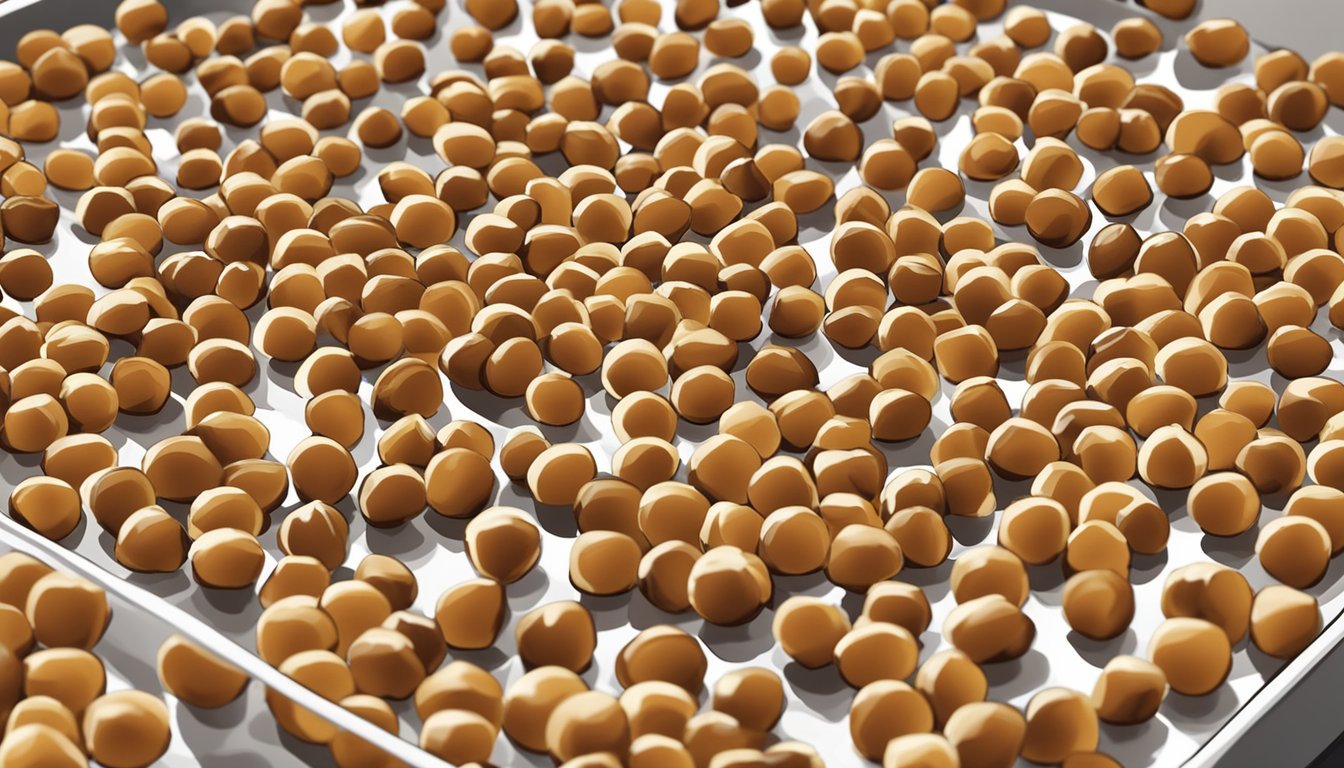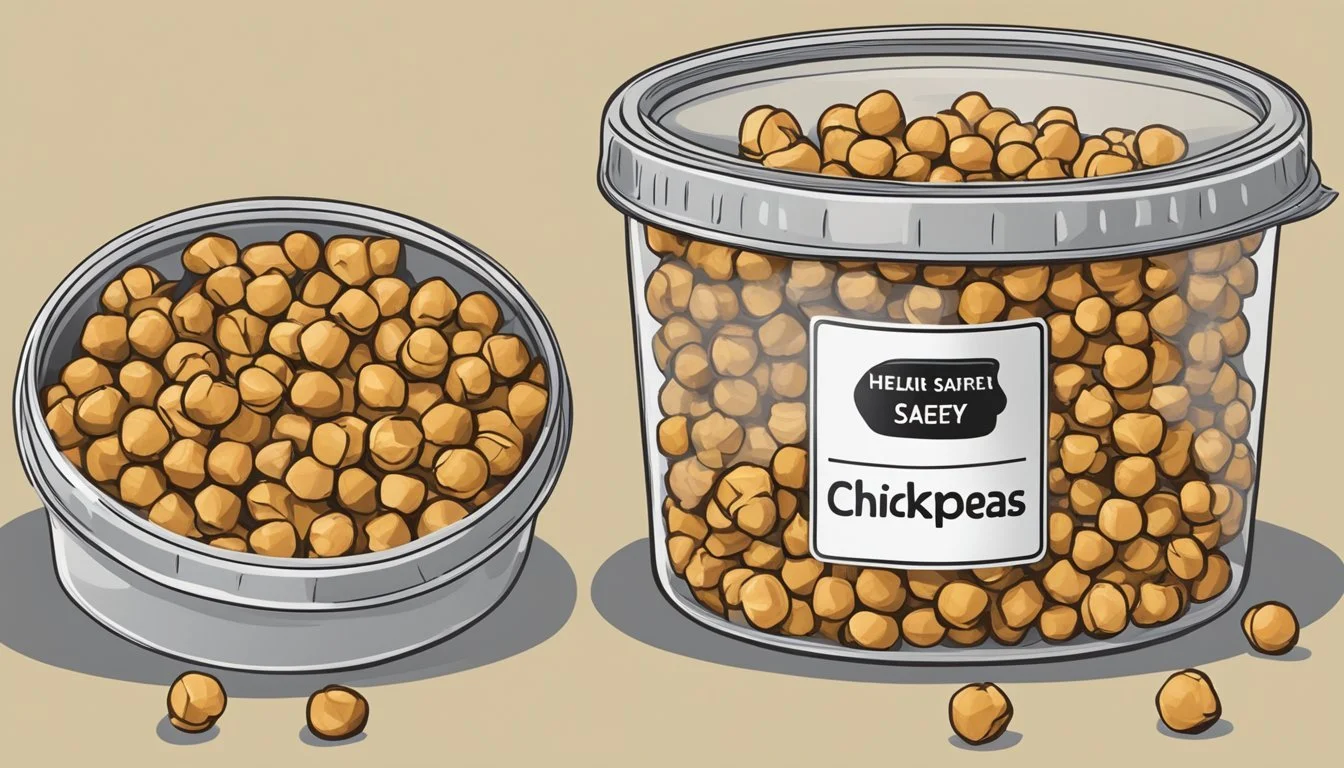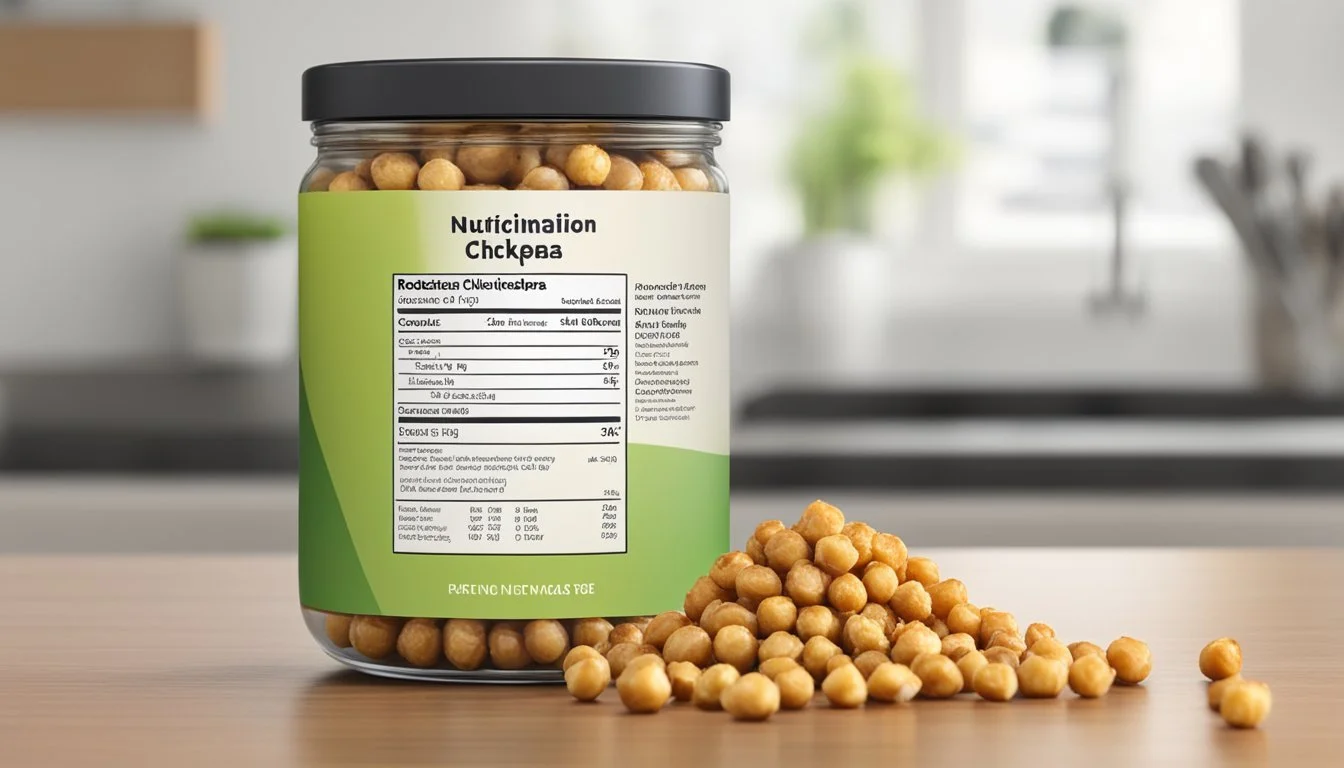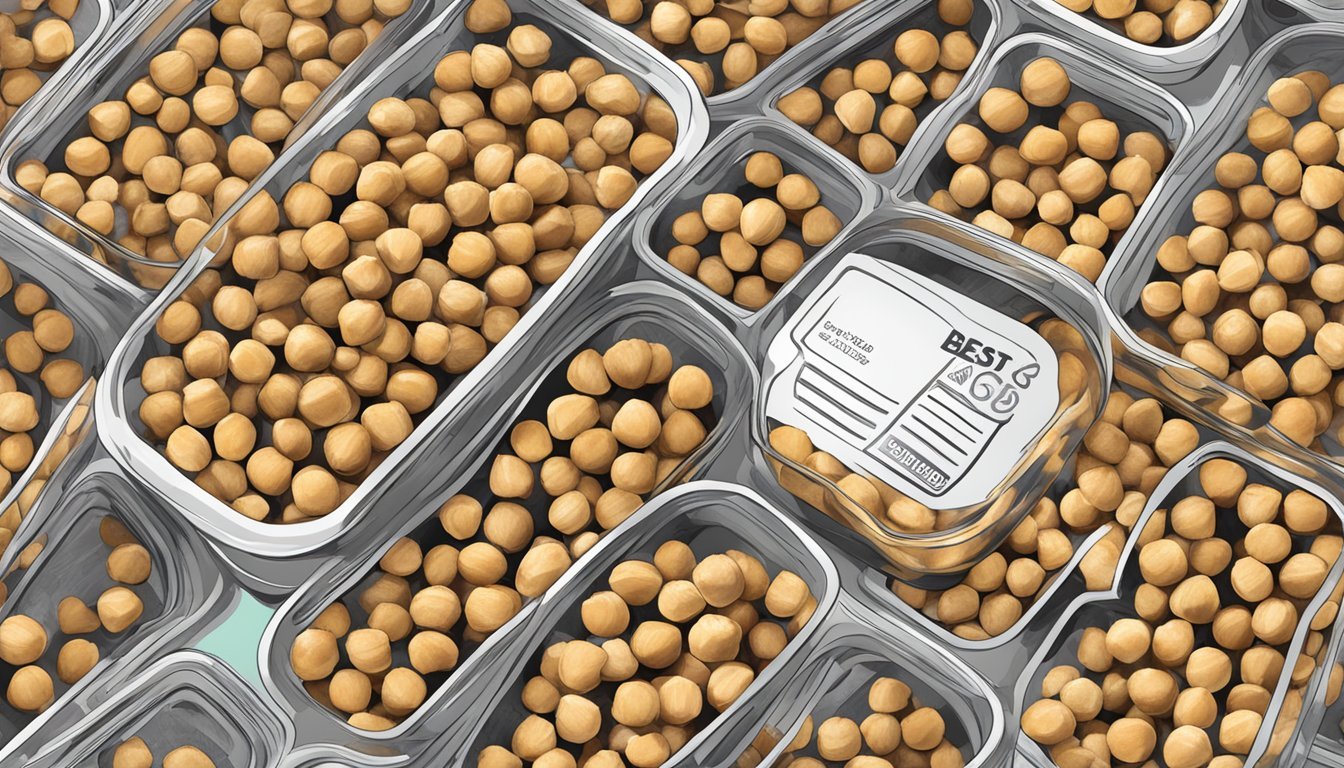How Long Do Roasted Chickpeas Last?
Shelf Life & Storage Tips
Roasted chickpeas have gained popularity as a nutritious snack thanks to their satisfying crunch and versatility in flavoring. As an excellent source of protein and fiber, they offer a healthier alternative to traditional processed snacks (What wine goes well with snacks?). They fit into various dietary preferences, making them a convenient option for those seeking to maintain a balanced diet without sacrificing taste.
The shelf life of roasted chickpeas is a point of consideration for consumers who value both health and convenience. Typically, these snacks can last up to two weeks at room temperature when stored in an airtight container. Refrigeration can extend their freshness, with a potential to keep for up to four weeks. Proper storage conditions are essential to preserving their crisp texture and preventing spoilage.
One should also consider factors such as the presence of additional ingredients, humidity levels, and the type of container used, as these can influence the longevity of roasted chickpeas. While refrigeration can extend their shelf life, it's important to note the potential impact on texture, as some consumers may prefer the crispness of chickpeas maintained at room temperature. With a clear understanding of these storage principles, individuals can enjoy roasted chickpeas as a healthy snack option without compromising on quality and flavor.
Benefits of Roasted Chickpeas
Roasted chickpeas offer a multitude of health benefits, making them an excellent addition to a balanced diet. They are a rich source of fiber, aiding in digestion and potentially reducing the risk of chronic diseases. Each serving of roasted chickpeas delivers a hearty dose of protein, which is essential for muscle repair and overall body function, making them particularly beneficial for vegans and vegetarians who may have more limited protein sources.
The carbohydrates in roasted chickpeas release energy slowly, providing a steady supply rather than a quick spike, which is especially helpful for blood sugar control. They also come packed with a variety of vitamins and minerals that support body functions; these nutrients include iron, potassium, magnesium, and B vitamins, among others.
Roasted chickpeas are versatile; they can be seasoned and added to various diets due to their neutral flavor. The crispy roasted version can be enjoyed as a snack, providing a healthier alternative to high-calorie treats, and their crunchy texture makes them a satisfying substitute for nuts in salads. Since they are both vegan and gluten-free, oven-roasted chickpeas are an inclusive food option suitable for almost everybody.
Moreover, oven-roasted chickpeas offer a nutritional advantage over their canned counterparts as they contain no preservatives or added sodium. Choosing to prepare oven-roasted chickpeas at home allows for control over the ingredients used, ensuring a nutrient-rich and wholesome snack. Whether enjoyed on their own or as part of a meal, roasted chickpeas are a nutrient-packed food that brings a multitude of benefits to the table.
Nutrient Profile:
Fiber: Aids with digestion and satiety.
Protein: Essential for various bodily functions.
Carbohydrates: Provide long-lasting energy.
Vitamins & Minerals: Support overall health.
Incorporating this nutritious snack into one's diet can contribute to overall well-being without sacrificing taste or texture.
Selection and Preparation
Proper selection and preparation are critical for ensuring the quality and taste of roasted chickpeas. Starting with the right type of chickpeas and using appropriate rinsing and soaking methods can significantly affect the final product. Careful seasoning further enhances flavor and appeal.
Choosing Chickpeas
When selecting chickpeas for roasting, one has two primary options: dried chickpeas or canned chickpeas. Dried chickpeas typically require advance preparation, including soaking and cooking, but they are often preferred for their firmer texture after roasting. Canned chickpeas offer convenience and save time as they are pre-cooked, but they may result in a softer texture.
Dried chickpeas: Opt for uniform, unblemished ones that are free from moisture or any signs of mold.
Canned chickpeas: Choose cans without dents or rust, and check for added sodium or preservatives if these are a concern.
Rinsing and Soaking
Rinsing is a vital step to remove debris and phytic acid, which can impair mineral absorption and digestion.
For dried chickpeas:
Rinse thoroughly under running water.
Soak for at least 4 hours, or overnight, to reduce cooking time and improve texture.
For canned chickpeas:
Rinse well to remove the preservation liquids and reduce sodium content.
Seasoning Options
Seasoning chickpeas before roasting is essential for achieving a palatable and aromatic snack. A wide range of spices may be used, depending on personal taste and cuisine preferences.
Basic spices: Salt is fundamental for enhancing flavor. Combine with black pepper for a simple yet effective seasoning.
Complex flavors:
Warm spices such as cumin and paprika create a deep, smoky taste.
For some heat, harissa or a pinch of chili powder works well.
Ethnic mixes like curry powder, Italian seasoning, or singular herbs like rosemary or oregano provide a distinct profile.
It's crucial to evenly coat the chickpeas with the chosen spices to ensure consistent flavor in every bite.
Cooking Techniques
The preparation of roasted chickpeas involves specific cooking techniques that guarantee optimal flavor and crispiness. Understanding the proper use of the oven, how to achieve a crispy texture, and awareness of alternative methods are crucial for creating this delightful snack.
Using the Oven
To roast chickpeas in the oven, one starts by spreading them out on a baking sheet, usually lined with parchment paper to prevent sticking. Preheating the oven to a temperature around 425 degrees Fahrenheit ensures that chickpeas will bake evenly. It's important to dry the chickpeas thoroughly before putting them in the oven, as moisture can impede achieving the desired crispiness.
Streamline your day by having baking sheets delivered to your door with our effortless online checkout.
Achieving Crispiness
A key aspect of roasting chickpeas is obtaining their characteristic crispy texture. After drying, tossing the chickpeas with olive oil and optional seasonings enhances taste and promotes an even golden brown finish. The chickpeas should be baked in a single layer to ensure that heat circulates around each chickpea. For extra crispiness, one can let them roast a few minutes longer, watching carefully to prevent burning.
Alternative Methods
While the oven is a common appliance for roasting chickpeas, there are alternative methods. A toaster oven can be used for smaller batches, following similar temperature guidelines and cooking times. Air fryers are another option, offering a quick way to cook and crisp the chickpeas by circulating hot air around them. Regardless of the method, the aim is to produce crunchy, flavorful chickpeas that are perfect as snacks or salad toppings.
Storing Roasted Chickpeas
Proper storage techniques extend the shelf life of roasted chickpeas while maintaining their texture and taste. Storing them away from moisture and at the right temperature is crucial for keeping them fresh.
Airtight Containers
Roasted chickpeas should be placed in an airtight container to protect them from moisture and other contaminants. Glass jars with tight-fitting lids are ideal for this purpose. Ensuring the chickpeas have cooled completely before sealing them in the container will prevent condensation, which can lead to a loss of crunchiness.
Refrigeration and Freezing
For longer-term storage, one may refrigerate or freeze roasted chickpeas. In the fridge, they maintain their quality for 1 to 2 months. When freezing, roasted chickpeas can be stored for up to 6 months. To freeze, spread them out on a baking sheet to freeze individually before transferring to a freezer-safe airtight container.
Shelf Life
At room temperature, roasted chickpeas last for 2-3 weeks when stored properly in an airtight container. The shelf life varies based on ingredients and seasonings used. Refrigeration significantly extends this period, promoting a shelf life of up to several months under optimal conditions.
Health and Safety Concerns
When storing roasted chickpeas, it’s crucial to pay attention to health and safety concerns to prevent foodborne illnesses. Chickpeas are a nutritious food product, but if not stored properly, they can harbor bacteria that may lead to health issues.
Moisture is one of the main culprits for bacterial growth in roasted chickpeas. To avoid this, roasted chickpeas should be stored in an airtight container and kept either at room temperature or in the refrigerator, ensuring they are completely dry before storage.
On the counter: At room temperature, roasted chickpeas need to be in a dry environment to prevent the introduction of moisture, which can lead to mold.
In the fridge: Lower temperatures slow down bacterial growth, but chickpeas must be sealed to avoid humidity.
Chickpeas on the counter can last for up to two weeks in an ideal environment. However, if one notices any unpleasant odors, a change in texture, or mold, they should discard the chickpeas immediately.
Storing roasted chickpeas in the refrigerator can extend their shelf life to up to four weeks. One must regularly check for signs of spoilage such as a slimy texture or a sour smell. If these signs are present, they indicate that the chickpeas are no longer safe to eat.
Storage Location Lifespan Precautions Counter Up to 2 weeks Dry, airtight container Refrigerator Up to 4 weeks Airtight container, check for spoilage
Food safety best practices dictate that any sign of spoilage should be taken seriously, and the product should not be consumed. Proper hygiene and frequent hand-washing should also be followed when handling roasted chickpeas to prevent cross-contamination.
Save time and hassle by getting airtight containers through our quick online ordering process.
Incorporating Roasted Chickpeas into Meals
Roasted chickpeas provide a delightful crunch and a nutty flavor, enhancing a variety of dishes from soups and salads to snacks. They serve as a nutritious and gluten-free alternative to croutons and can be a key ingredient in creating a savory profile in meals.
Salads and Soups
Incorporating roasted chickpeas into salads adds a satisfying crunch and boosts the protein content. They can be sprinkled over leafy greens or mixed into grain-based salads to contribute texture. For soups, roasted chickpeas offer a contrast in consistency when used as a garnish. Unlike traditional croutons, they remain dry and crispy for a more extended period.
Caesar Salad: Toss chickpeas with lettuce, parmesan, and dressing.
Lentil Soup: Garnish with chickpeas before serving for added texture.
As a Snack or Appetizer
Roasted chickpeas can stand alone as a snack, seasoned with various spices, or be part of an appetizer platter. They are an excellent alternative to nuts or chips due to their high fiber and low fat content.
Hummus Dip: Pair with a bowl of hummus for dipping.
Snack Mix: Combine with dried fruit and nuts for a hearty trail mix.
Creative Recipe Ideas
For those who enjoy experimenting, roasted chickpeas are versatile ingredients in recipes. One can incorporate them into stuffed peppers for a protein boost or blend them into a crunchy topping for casseroles.
Stuffed Bell Peppers: Mix in with rice, vegetables, and cheese.
Casserole Topping: Use as a crust for a textural variety.
Nutritional Information
Roasted chickpeas are known for their health benefits, as they are a good source of protein and fiber. Generally, a serving size of roasted chickpeas, which is about one ounce (28 grams), contains approximately 120-130 calories. The macronutrient composition of roasted chickpeas makes them a nutritious snack option. Here is a breakdown of the essential nutrients found in roasted chickpeas:
Macronutrients:
Protein: Rich in plant-based protein, roasted chickpeas offer about 6 grams per serving. Protein is vital for muscle repair and overall bodily function.
Fiber: With around 5 grams of dietary fiber, they contribute to digestive health and can aid in maintaining a healthy weight.
Fat: They are low in fat, with around 2 to 3 grams per serving, much of which is unsaturated and beneficial to heart health.
Carbohydrates: A serving typically contains about 18 to 20 grams of carbohydrates, providing a steady source of energy.
Micronutrients:
Sodium: Content may vary, especially if additional salt is used during roasting. Homemade versions can be made with less sodium compared to store-bought options.
Potassium: An essential mineral for cardiovascular health, roasted chickpeas contain potassium, although the amount can differ depending on the preparation method.
Calcium and Iron: They moderately contribute to the daily intake of calcium and iron, which are crucial for bone health and oxygen transportation in the blood, respectively.
Vitamins such as vitamin A and vitamin C are present in smaller amounts. While roasted chickpeas may not be a significant source of these vitamins, they could contribute to the overall daily vitamin intake when consumed as part of a balanced diet.
By choosing roasted chickpeas as a snack, individuals can enjoy a food that supports nutrition without the high fat or calorie content associated with many other snack foods.
Tips for Perfect Roasted Chickpeas
To achieve perfectly roasted chickpeas that are crunchy and flavorful, one should follow these guidelines:
Oil: For a crispy outcome, lightly coat the chickpeas in oil. Using a spray or approximately 1/2 teaspoon per can of chickpeas ensures they aren't soaked, which is crucial for that desirable crunch.
Temperature: A consistent oven temperature of 400°F (200°C) provides the ideal environment for roasting chickpeas to golden perfection.
When it comes to seasonings, the world is your oyster. Whether you prefer savory, spicy, or sweet flavors, the following spices perfectly complement roasted chickpeas:
Flavor Profile Spices & Seasonings Savory Garlic powder, kosher salt, thyme Spicy Chili powder, cayenne, cayenne pepper Sweet Cinnamon, sugar Smoked Smoked paprika
Seasoning: Apply seasonings immediately after roasting while the chickpeas are still warm to ensure they stick well.
Spread: Give them space on the baking sheet. Crowding can lead to uneven roasting and sogginess.
Stirring: Stir or shake the pan every 10 minutes for even roasting and to avoid burning.
Consider these additional tips:
Peeling: For an even crunchier texture, one might choose to peel the chickpeas, although it's not a requirement.
Salting: Both kosher and sea salt are excellent for drawing out natural flavors, but salt should be used judiciously to avoid overwhelming the chickpeas.
After roasting, let the chickpeas cool completely before serving to reach optimal crunchiness.
Frequently Asked Questions
In this section, you'll find detailed answers to some common queries regarding the shelf life of roasted chickpeas and tips on reheating them to retain their delightful crunch.
How Long Do Roasted Chickpeas Last?
Roasted chickpeas, when stored properly, can last up to two weeks at room temperature in an airtight container. If placed in the refrigerator, their freshness extends to about four weeks. For those who prefer freezing, roasted chickpeas can remain in good condition for one to two months. It's pivotal to note that oven roasted chickpeas tend to lose their crispiness over time, and the key to prolonging their crunch is ensuring they are stored away from moisture.
Storage Recommendations:
Room Temperature: Airtight container, up to 2 weeks.
Refrigerator: Airtight container, up to 4 weeks.
Freezer: Airtight bag/container, 1-2 months.
Best Practices for Reheating
To restore the crispy nature of roasted chickpeas, reheating them in an oven is the most effective method. Spread the chickpeas evenly on a baking sheet and warm them at 350°F (175°C) for about 5 to 10 minutes. Be attentive to avoid burning them. The goal is simply to re-crisp the chickpeas, not cook them further. Reheating can help in reducing the moisture that may have been absorbed, especially when the chickpeas were stored in the refrigerator.













